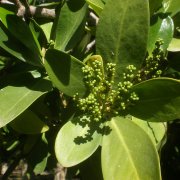Care of the tree Corynocarpus laevigatus or New Zealand laurel |
|
The genus Corynocarpus, family Corynocarpaceae, comprises 6 species of shrubs and trees native to New Zealand, Australia and Malaysia. Some species are: Corynocarpus laevigatus, Corynocarpus rupestris, Corynocarpus australasicus. Common names: New Zealand laurel, Karaka. This species is native to New Zealand. They are evergreen trees with a dense crown and thick trunk that reach 15 meters (49.2 feet) in height. They have bright large leaves that are dark green on the upper side and light green on the underside. The flowers are small and yellowish, white or cream in color and appear in erect panicles. They bloom in winter and spring. They produce edible ovoid fruits; the seeds are poisonous. New Zealand laurel is used as isolated specimens in the garden or in large pots as indoor, patio or terrace plants. It's ideal for Mediterranean coastal gardens. Fruits that fall to the ground can smell bad. Corynocarpus laevigatus can grow in full sun or semi-shade exposure and in temperate climates. It resists light frosts when they are adults. The soil can be a mixture of garden substrate with coarse sand and a little organic matter. Karaka resists a few days of drought; water regularly so the substrate never dries out completely. Fertilize in fall with compost or manure. New Zealand laurel does not need pruning. Corynocarpus laevigatus is a plant resistant to pests and diseases. Karaka propagates by cuttings but it's a difficult process; it's recommended to use seeds sown in spring. |
Images of the tree Corynocarpus laevigatus or New Zealand laurel |
Find plants
Corynocarpus laevigatus or New Zealand laurel | Care and Growing
© 2025 FavThemes


